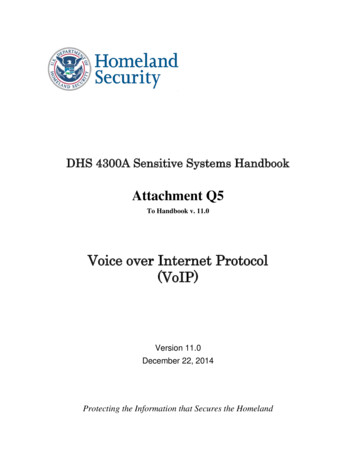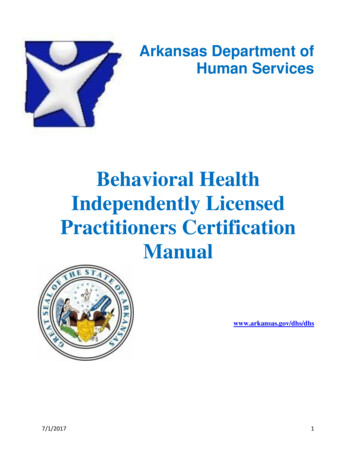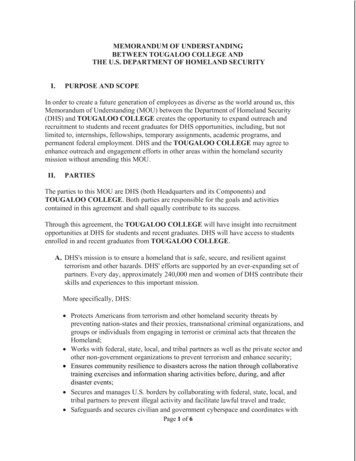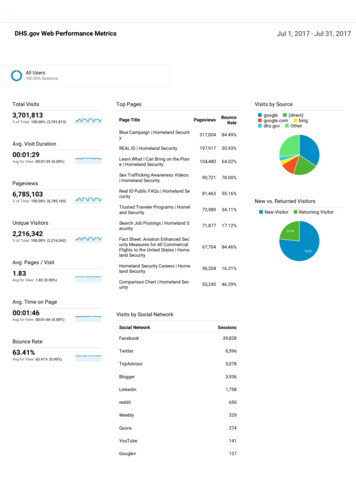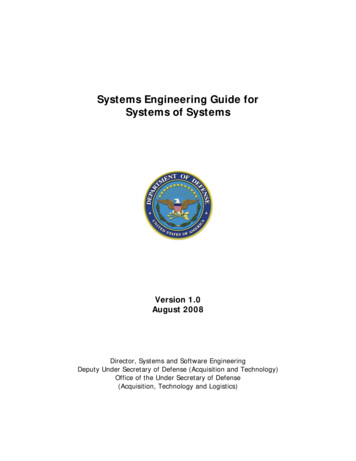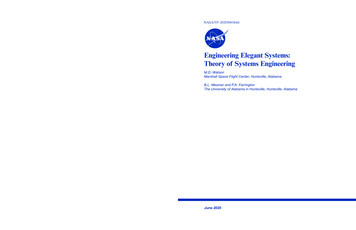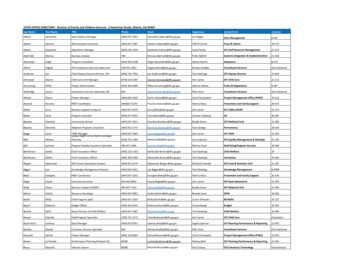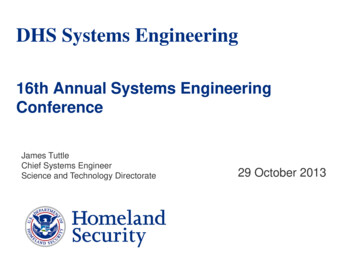
Transcription
DHS Systems Engineering16th Annual Systems EngineeringConferenceJames TuttleChief Systems EngineerScience and Technology Directorate29 October 2013
2
Who became part of DHS? U.S. Customs Service (Treasury)Immigration and Naturalization Service (Justice)Federal Protective ServiceTransportation Security Administration (Transportation)Federal Law Enforcement Training Center (Treasury)Animal and Plant Health Inspection Service (partial, Agriculture)Office for Domestic Preparedness (Justice)Federal Emergency Management AgencyStrategic National Stockpile and the National Disaster Medical System (Health andHuman Services)Nuclear Incident Response Team (Energy)Domestic Emergency Support Teams (Justice)National Domestic Preparedness Office (FBI)U.S. Secret Service (Treasury)U.S. Coast Guard (Transportation)
DHS Core Mission Areas
The DHS Acquisition Portfolio 135 Major Programs representing 150B investment Significant Diversity (Products and Approaches) Products include ships, aircraft, IT business systems, facilities,command and control, sensor/detectors, Approaches include full development / production, Commercial Offthe Shelf (COTS) integration, commodity purchase, and mission /mission support services. Acquisition is performed by DHS Operating Componentsand some HQ organizations Need for a more robust PPBE processPresenter’s NameJune 17, 20035
INTEGRATED INVESTMENT LIFE CYCLE MANAGEMENTStrategy Component/Mission-driven Goal: rationalizeinvestmentsPLANNINGNEXUSProgram Implementation and OperationsStrategy —› seCapabilities &Requirements PhaseProgramming & BudgetingPhaseInvestment OversightPhaseArticulates theSecretary’s key priorities andproposed “end state”Develops future targetoperational stateWeighs strategic guidance(IPG) and capabilityrequirements againstavailable resourcesEnsures overalloversight of investmentexecutionProduces quantifiablestrategic outcomes andmeasuresInformed by QHSR andhigh level Strategic PlansIdentifies and prioritizesexisting gaps and overlapsin the Department’scapabilitiesDetermines alternativecourses of action to addresscapability shortfallsAllocates resources toensure a balanced andcredible DHS budget andFuture Year HomelandSecurity ProgramAssesses investments againstexpected outcomesInforms future strategies,capabilities and resourcedecisionsProduces Integrated PlanningGuidance (IPG) and MissionStrategiesChartersportfolio teamsMission and Function Portfolio TeamsProvide cross-Component expertise to perform analysis across IILCM phasesPILOT PORTFOLIOS: Bio-Defense, Screening & Vetting, Cyber SecurityDATA MART / BUSINESS INTELLIGENCEFeedback Loop
DHS Acquisition Life Cycle Framework (ALF)NEED PHASEANALYZE/SELECT PHASEOBTAIN PHASEWe identify the alternativesand resource requirementsWe define theproblem.PRODUCE/DEPLOY/SUPPORT PHASEWe develop and evaluateCapabilities.We produce and maintainthose capabilities.2C0CollectionPoint forGaps &Needs2A1ValidateNeeds2B2A: ApproveProgram3Field andSupportProgramProducts2B: ApproveSupportingProjects/Contracts2C: ApproveLow RateProduction Acquisition Decision Event
DHS Acquisition Lifecycle & SELC FrameworkPurpose: Establish a common System Engineering Life Cycle Framework andensure appropriate activities are planned and implemented to comply with FederalAcquisition Regulations (FAR), the Clinger-Cohen Act, and other Federal Laws.Acquisition Lifecycle Deploy &SupportObtainNeedsValidationSERSolution nPDRDesignCDRTRRPRR OTRR3ORRPIRDevelopment Integration Implementation Operations &MaintenanceSystems Engineering Lifecycle (SELC)Presenter’s NameJune 17, 20038
Updated SELC Guidebook Philosophy Developed to help identify appropriate SE activities are planned and implemented Incorporates “Best Practices” and guidance from DoD, NASA, INCOSE, DHSComponent processes, and industry leaders Provides clear message that programs/projects need to engage in critical thinking No longer focuses on policy or mandates, but on actual SE activities to be performed Establishes requirement for development of a Systems Engineering Plan (SEP) Tailoring is expected Contributes to commitment to “one ALF” and “one SELC” across DHS Focus is on the Government PM in a role of overseeing when appropriate Provides cross-references to other Sections to show process linkages across activities Stresses early evaluation/development of advanced technology along with continuousTechnology Maturation and Assessment Leverages annexes to provide more detailed information and examplesPresenter’s NameJune 17, 20039
Updated SELC–Focus on Technical Execution Provides more detail on the steps and analysis necessary to execute aprogram Extensive cross-referencing and links to Annexes, and applicablepolicies/procedures to minimize duplication and show theinterrelationships of activities throughout the life cycle Consolidated Systems Engineering, supporting activities, and resultingartifacts from DHS and applicable statutes, regulations, and policiesinto an integrated usable Guidebook Integrates critical compliance activities based on various federallaws/regulations and other SELC considerations throughout the SELC toprovide a direct understanding of when and how they were to be appliedto the program Privacy, Security, Section 508 Accessibility, Human Systems Integration,EOSH, etc Presenter’s NameJune 17, 200310
Emphasizes Critical Thinking and Planning Emphasizes the need for Critical Thinking and early comprehensiveplanning needed to enable successful system development Fundamentally changed the SELC from a Stage and Documentfocused process to an Activity focused process Recognized that SELC activities are often iterative or concurrent in nature and notstrictly performed in a stepwise or sequential manor Enable the program to focus on execution of the activities that will ultimately lead toa delivered capability vice focusing on development of documents Artifacts and reviews are still critical elements of the SELC, but are the result of theactivities to document and assess progress Integrates the evaluation or development of advanced science andtechnology into the early phases of program definition and providesa constant drumbeat on Technology Maturation and AssessmentPresenter’s NameJune 17, 200311
Emphasizes TailoringProvides detailed guidance so a Program can develop theirspecific “Tailored plan” based on the unique characteristicsof the Program regardless of program type and size Encourages, almost demands, tailoring the SELC for every program Proper selection of a development methodology and logical tailoring of theSELC activities, artifacts, and reviews based on the specific characteristic of aprogram and the program team Stresses the important of Program Team to really engage to understandthe program, its users/stakeholders, scope and technical challenges toplan to do the “right” work Enables executers and oversight to really know what the program will doand what should be expected and when Gets Programs and Oversight on the same page earlyStill “one ALF” and “one SELC” across DHSPresenter’s NameJune 17, 200312
Enables Logical Tailoring of Program ActivitiesGuidebook points to a SELC Tailoring Example Annex that providesexamples of how the SELC is tailored for various type of programs Demonstrates the level of detail and amount of critical thinking a Programshould engage in to properly plan the effort for a specific program Includes examples tailoring approaches for: Small/less complex development programsCOTS/GOTS/NDI programsIT Infrastructure and Services programsStand Alone Service programsFacilities and Construction ProgramsPrograms utilizing Agile development methods (IT systems) Can serve as a starting point and be referenced to minimize thesize/content of the SELC Tailoring Plan while still requiring the criticalthinking and justification Is a living artifact that can grow and change based on actual experience toprovide better guidance to future programsPresenter’s NameJune 17, 200313
SE Technical Management ProcessesInstilling Systems Engineering Methods and Processes throughadoption of “Industry Standard” Technical Management Processes These processes include: Requirements Engineering Technical Planning Technical Risk Management Technical Configuration and Change Management Interface Management Decision Analysis Technical Assessment Technical Data Management Technical Management Processes are integrated into initial Planning activities oncethe Program is officially designated a Program of Record These processes are then applied throughout SELC activities and the TechnicalReview process evaluates the program use of and adherence to these processes Documented in a newly implemented Systems Engineering Plan (SEP)Presenter’s NameJune 17, 200314
Recognizes the impact of “Embedded IT” in new systemsThe New SELC Guidebook recognizes and accounts forthe proliferation of IT elements within newsystems/capabilities Defined “Embedded IT” to describe the IT elements within non-ITsystems that enable the system to perform its primary function Many systems such as detectors use embedded IT to enable or enhance theirprimary function and may even transmit that detection information acrossnetworks Non-IT Programs must now consider many IT related activities until it isdetermined that these activities are not necessary Security Assessment and AccreditationPrivacySection 508 AccessibilityTechnology InsertionPresenter’s NameJune 17, 200315
Acquisition Career ManagementRobust Certification Programs Cost EstimatingLife Cycle LogisticsTest and EvaluationProgram ManagementProgram Financial ManagerFederal Acquisition Certification, Contracting(FAC-C)Federal Acquisition Certification-Contracting OfficerRepresentative (FAC-COR) Ordering Official6 April 2012, DHS Acquisition Workforce Warrant ProgramDivision issued an Acquisition Certification Systems EngineeringPolicy for Systems EngineeringEstablish a professional certification program to train and develop ourcurrent workforce and provide mandatory education, training, andexperience requirements for each specific acquisition position and specialtyPresenter’s NameJune 17, 200316
System Engineering Acquisition Certification Develop Core CompetenciesLevel I: Remembering & UnderstandingLevel II: Applying & AnalyzingLevel III: Evaluating & Creating (Synergizing) Draft SE Certification Policy Certification Policy defines requirements for Core Competencies Education, Experience and Training Develop DHS specific courses to meet Core Competencies Establish which Core Competencies will met with training Develop Learning Objectives and Course Outlines Develop Course Pilot Course Finalize CourseSkills stsPresenter’s NameTraining and ToolsEducationJune 17, 200317
DHS Systems Engineering FFRDCSystems EngineeringAcquisition SE Support Architecture development Program/Project Management Independent technicalassessments RFP development & sourceselection support Proof-of-Concept Risk and opportunityanalysis Cost, schedule, performance, risktrades Experimentation Software systemsengineering System concept development Requirements analysisModeling and simulation Analysis of AlternativesTest and evaluation Enterprise SystemsEngineeringReview/analysis of design, designalternatives Requirements EngineeringOrganizational ChangeManagementIntegration &Interoperability System of systems integration Standards developmentCreating mission capability workingthrough needs, opportunities and constraints18
Summary DHS enterprise is much larger the DHS and has a wide range ofmission areas DHS has a civilian / law enforcement culture Acquisition still somewhat synonymous with procurement DHS realizes Systems Engineering needs to be institutionalize Stood-up Level I,II, & III SE certification program Updated SELC Guidance based on best practices across theFederal government and Industry Developing and refining new Integrated Investment Life CycleManagement (IILCM) process Looking to continue collaboration with other government agenciesPresenter’s NameJune 17, 200319
Federal Acquisition Certification, Contracting(FAC-C) Federal Acquisition Certification-Contracting Officer Representative (FAC-COR) Ordering Official Warrant Program Systems Engineering . 6 April 2012, DHS Acquisition Workforce Division issued an Acquisition Certification Policy for Systems Engineering Establish a .

